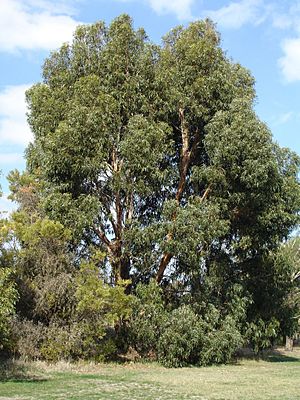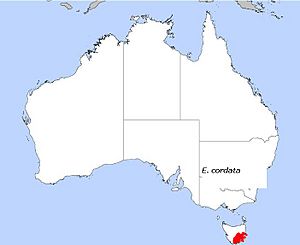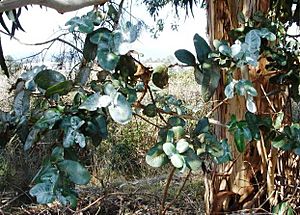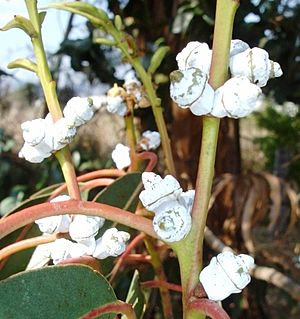Heart-leaved silver gum facts for kids
Quick facts for kids Heart-leaved silver gum |
|
|---|---|
 |
|
| Eucalyptus cordata, Melbourne | |
| Scientific classification | |
| Genus: |
Eucalyptus
|
| Species: |
cordata
|
 |
|
| E. cordata, field distribution | |
The Eucalyptus cordata, also known as the heart-leaved silver gum, is a special type of tree or shrub. It only grows naturally in Tasmania, an island in Australia. This means it is "endemic" to Tasmania.
This plant has smooth bark that can be greenish-yellow, brown, or grey. Its leaves are often heart-shaped and have a cool, silvery-blue color, which is called "glaucous." The flower buds also look silvery-blue and grow in groups of three. When it blooms, it has white flowers. Later, it grows fruit that looks like a small cup or cylinder.
Contents
What the Heart-leaved Silver Gum Looks Like
The Heart-leaved Silver Gum can be a small, bushy shrub or a medium-sized tree. It usually grows between 3 and 25 meters (about 10 to 82 feet) tall. It has smooth bark that can be greenish-yellow, brown, or grey. Sometimes, older trees have rough bark near the bottom of their trunk.
This tree often has a special woody swelling at its base called a lignotuber. This helps the plant regrow if it gets damaged, for example, by fire.
Leaves and Branches
The branches of this gum tree are often covered in a silvery-blue coating. Most of the leaves on a mature tree are "juvenile" leaves. These are the leaves that grow on young plants. Only the tallest trees might have "adult" leaves at the very top.
Young plants and new shoots have leaves that grow in opposite pairs. These leaves are egg-shaped or almost round. They are about 30-55 mm long and 20-55 mm wide, often with wavy edges.
Adult leaves, found only on tall trees, grow one after another along the stem. They are shaped like a spear, about 75-130 mm long and 20-38 mm wide. These adult leaves have a flat stalk about 15-20 mm long.
Flowers and Fruit
The flower buds grow in groups of three in the "axils" of the leaves. An axil is the angle between a leaf and the stem. Each group of buds sits on a small stalk called a peduncle, which is 2-9 mm long. The individual buds are either directly attached or have a very short stalk.
Mature buds are oval or club-shaped. They are green or silvery-blue and measure about 9-13 mm long and 7-9 mm wide. The top part of the bud, called the operculum, can be rounded, flat, or have a small beak.
The Heart-leaved Silver Gum can flower in most months of the year. However, it blooms most often between May and June, and again from September to November. Its flowers are white.
After flowering, the plant produces woody fruits. These fruits are shaped like a cup, cylinder, or half-sphere. They are about 7-13 mm long and 9-15 mm wide. Like the buds, they are either directly attached or have a very short stalk.
How it Got its Name
The Heart-leaved Silver Gum was first officially described in 1806 by a scientist named Jacques Labillardière. He wrote about it in his book, Novae Hollandiae Plantarum Specimen.
The scientific name cordata comes from a Latin word meaning "heart-shaped." This refers to the shape of the plant's leaves.
In 2008, three scientists, Dean Nicolle, Brad Potts, and Gay McKinnon, found two slightly different types of this plant. These are called "subspecies." The names they gave them are:
- Eucalyptus cordata subsp. cordata: This type has branches that are round when you look at them in a cross-section.
- Eucalyptus cordata subsp. quadrangulosa: This type has branches that are square when you look at them in a cross-section.
Where it Grows
The Heart-leaved Silver Gum is only found in a small area in the south-east of Tasmania. It grows at medium heights, for example, on the lower slopes of Mount Wellington. You can also find it on the Snug Plains and around places like Port Arthur and Moogara.
This tree is quite attractive because of its large, silvery-blue juvenile leaves. These leaves often stay on the tree even as it gets older.
The subspecies cordata mainly grows south of Triabunna. It can also be found on Bruny and Maria Islands. The subspecies quadrangulosa is mostly found around the Wellington Range, but it is most common on the Snug Plains.



